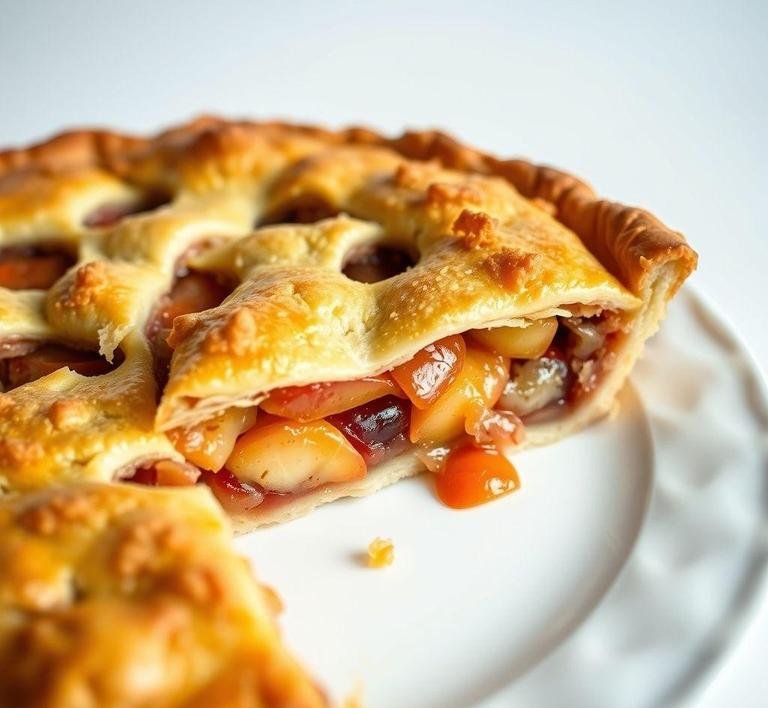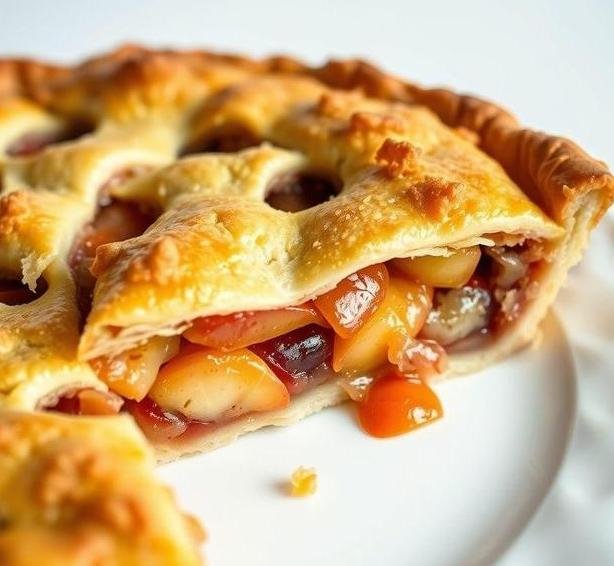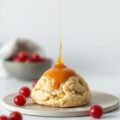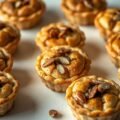Mary Berry’s Windfall Pie is a delightful celebration of autumn’s bounty, capturing the essence of those fallen fruits that often go overlooked in our gardens or local markets. The term ‘windfall’ refers to fruit that has naturally fallen from the tree, often considered less desirable because it’s not perfectly pristine, but packed with ripe, juicy flavor. Mary Berry, the beloved British culinary icon, has taken this humble fruit and transformed it into a deliciously comforting pie that embodies warmth, nostalgia, and the joy of seasonal cooking.
Unlike many pies that call for supermarket apples or pre-packaged fillings, Windfall Pie is an ode to using what nature provides generously but impermanently-whether that be bruised apples, pears, plums, or even quinces. This pie is both practical and scrumptious, a way to reduce waste while creating something spectacularly tasty. It’s a spiced, tender-crusted fruit pie, often dotted with a little sugar and lemon juice to balance the sweetness with a fresh zing. It’s perfect for cozy autumn afternoons or as a heartwarming dessert after a Sunday roast.
Mary Berry’s recipe is famed for its simplicity yet impeccable results. Her approach ensures that the fruit filling is perfectly tender but not mushy, encased in a buttery, flaky crust that melts in your mouth. It’s an iconic example of British baking that honors tradition, thrift, and above all, flavor.
Mary Berry’s Windfall Pie Recipe
Ingredients Needed

To make Mary Berry’s Windfall Pie, you’ll want to gather the freshest, ripest fruit you can find. Here’s the typical ingredient list that forms the backbone of this delicious pie:
For The Filling
- 6 to 8 medium-sized windfall apples or a mix of windfall apples and pears (about 1.2 kg/2.5 lbs)
- 1 lemon (zested and juiced) – this adds a bright, fresh acidity to balance the sweetness
- 100g (½ cup) caster sugar (you can adjust based on how sweet your fruit is)
- 1 tsp ground cinnamon – adds warmth and depth
- ½ tsp ground nutmeg – a subtle spice that complements the apples beautifully
- A pinch of salt – to enhance all the flavors
For The Pastry
- 225g (1 ¾ cups) plain (all-purpose) flour
- 110g (½ cup) cold unsalted butter, diced – the secret to that flaky texture
- 2-3 tbsp cold water (adjust as needed)
- 1 tbsp caster sugar – for a slightly sweet crust (optional)
- A little beaten egg or milk – for brushing the crust before baking
Optionally, you might add a handful of raisins or sultanas to the filling for a touch of extra sweetness and texture. Some recipes also sprinkle sugar on top of the crust for a sparkly finish.
Equipment Needed
While Mary Berry’s Windfall Pie doesn’t require any special gadgets, having the right tools at hand makes the process smoother and more enjoyable:
- Mixing bowls: One large bowl for your fruit filling and another for your pastry dough.
- Pastry cutter or food processor: To rub the butter into the flour quickly and evenly. If you don’t have one, your fingertips work perfectly fine.
- Rolling pin: To roll out the pastry evenly for a crisp, thin crust.
- Measuring spoons and scales: For precise ingredient amounts-especially important for the pastry.
- Sharp knife or apple corer: To peel, core, and slice your fruit cleanly.
- Pie dish (around 20-23 cm / 8-9 inches in diameter): A classic ceramic or glass dish works beautifully.
- Baking sheet: To place under the pie in the oven, catching any drips and keeping your oven clean.
- Pastry brush: For glazing the pie crust with egg wash or milk.
- Cooling rack: To cool the pie evenly after baking.
Instructions To Make Mary Berry’s Windfall Pie
Now, here’s the step-by-step magic behind creating this quintessential British pie:
1. Prepare The Fruit Filling
- Start by peeling, coring, and slicing your windfall apples (and pears if using) into uniform pieces about 1cm thick.
- Place the sliced fruit into a large mixing bowl.
- Add the lemon zest and juice, caster sugar, ground cinnamon, nutmeg, and a pinch of salt.
- Toss everything gently but thoroughly to coat all the fruit in the sugar and spices.
- Set the mixture aside to macerate while you prepare the pastry. This helps the fruit release some of its juices, making for a juicy filling.
2. Make The Pastry
- In a large bowl, combine the plain flour and caster sugar.
- Add the cold diced butter, then rub it into the flour using your fingertips or a pastry cutter until the mixture resembles coarse breadcrumbs with some pea-sized lumps.
- Slowly add the cold water, one tablespoon at a time, mixing gently until the dough just comes together. Avoid overworking the dough to keep it tender.
- Shape the dough into a ball, flatten it slightly, wrap in cling film, and refrigerate for at least 20 minutes.
3. Roll Out The Pastry
- Remove two-thirds of the chilled dough for the bottom crust.
- On a lightly floured surface, roll out the dough into a circle large enough to fit your pie dish, about 3 cm larger than the dish’s diameter.
- Carefully lift the pastry and line your pie dish, pressing gently to fit it snugly into the edges.
4. Assemble The Pie
- Spoon the fruit filling into the pastry-lined dish, spreading it out evenly.
- Roll out the remaining pastry for the top crust.
- Place the top crust over the filling, trimming any excess pastry.
- Press the edges together and crimp with your fingers or a fork to seal.
- Cut a few small slits in the top crust to allow steam to escape during baking.
- Brush the top with beaten egg or milk, and sprinkle a little sugar for a golden, crisp finish.
5. Bake The Pie
- Preheat your oven to 190°C (375°F) conventional or 170°C (340°F) fan-assisted.
- Place the pie on a baking sheet and bake for 40-45 minutes or until the crust is golden and the filling is bubbling.
- Check halfway through; if the crust browns too quickly, cover loosely with foil.
6. Cool And Serve
- Once baked, allow the pie to cool on a wire rack for at least 20 minutes to let the juices thicken.
- Serve warm or at room temperature with custard, cream, or ice cream for a comforting treat.
Tips And Tricks
Making a perfect Windfall Pie is a joy, but these insider tips from Mary Berry’s baking wisdom and my own experience can elevate your pie game:
- Use a mix of tart and sweet apples: This balance gives the filling depth of flavor-think Granny Smith with Cox’s Orange Pippin or Bramley apples for a traditional tang.
- Don’t skip the lemon: The acidity brightens the filling and prevents the fruit from turning brown.
- Keep everything cold: When making the pastry, the colder the butter and water, the flakier your crust will be. Warm butter melts prematurely and creates a dense crust.
- Rest the pastry: Chilling the dough helps relax the gluten, so the crust doesn’t shrink during baking.
- Vent the top crust: Those slits are essential! Without them, your pie might bubble over or the crust can become soggy.
- Protect your crust: If the edges brown too fast, cover them with foil or a pie crust shield halfway through baking.
- Make it ahead: Windfall Pie tastes even better the next day when the flavors have melded. Reheat gently before serving.
- Customize with spices: Feel free to experiment with cardamom or ginger for a unique twist.
Mary Berry’s Windfall Pie is more than just a dessert; it’s a heartwarming tradition and a brilliant example of sustainable, seasonal cooking. By embracing the natural gifts of autumn’s fallen fruit, this pie encourages us to appreciate the beauty in imperfection and the joy of homemade goodness. Whether you’re baking it for a family gathering, a cozy afternoon tea, or just to savor the flavors of the season, this pie brings comfort, nostalgia, and a delicious story to your table.
The buttery, flaky crust paired with a spiced, tender fruit filling creates a balance of textures and flavors that is simply irresistible. Mary Berry’s straightforward recipe makes it accessible for bakers of all levels, ensuring that everyone can enjoy a slice of this classic British treat. So next time you spot some windfall fruit, grab your rolling pin and whip up a pie that’s bursting with warmth, flavor, and a bit of magic.
Easy Recipe Variations For Mary Berry’s Windfall Pie

Mary Berry’s Windfall Pie is a wonderful celebration of autumn’s bounty, traditionally crafted from a medley of freshly picked fruits-apples, pears, quinces, and sometimes even plums-baked lovingly beneath a golden, buttery crust. But one of the joys of this recipe is its versatility; it’s like a canvas inviting your personal touch. If you want to keep the spirit of Mary’s classic but add your own twist, there are several easy variations to explore.
1. Spice it Up:
Adding warming spices can elevate the pie’s flavor to new heights. Consider mixing in cinnamon, nutmeg, or allspice with the fruit before baking. A pinch of ground cloves or ginger can add an exciting hint of warmth and complexity. For an even richer aroma, try infusing the filling with a splash of vanilla extract or a zest of orange.
2. Sweeten and Tart it Your Way:
Depending on your fruit choices, you may want to adjust the sweetness. If using particularly tart fruits like crab apples or quinces, a spoonful of honey, maple syrup, or brown sugar can balance the flavors beautifully. Conversely, sweeter fruits like ripe pears or dessert apples might require less added sugar to let their natural sweetness shine.
3. Texture Twists:
The classic pie crust is delightful, but why not experiment with textures? A crumble topping made from oats, butter, brown sugar, and chopped nuts adds a lovely crunch. Or, try a lattice crust to show off the colorful filling and add a decorative touch. For a gluten-free twist, substitute the regular flour in the crust with almond flour or a gluten-free blend.
4. Adding Nuts and Extras:
Sprinkling chopped walnuts, pecans, or hazelnuts into the filling before baking can introduce a satisfying crunch and depth of flavor. Dried fruits like raisins or cranberries can also be tossed in for bursts of sweetness and a chewy contrast.
5. Savory-Sweet Fusion:
For an adventurous spin, add a sprinkle of grated mature cheddar cheese on top of the pie crust before baking. The sharpness of the cheese paired with the sweetness of the fruit is a classic British combination that’s surprisingly delightful.
These variations allow you to personalize Mary Berry’s Windfall Pie while respecting the original’s essence – a warm, comforting slice of seasonal goodness that feels like a hug in dessert form.
Storing Leftovers
One of the best things about Windfall Pie is that it tastes just as lovely the next day-sometimes even better-as the flavors have more time to meld and develop. Proper storage ensures your pie stays fresh and delicious, ready to be enjoyed again and again.
1. Room Temperature:
If you plan to eat the leftover pie within a day, you can store it covered loosely with foil or plastic wrap on the counter at room temperature. This keeps the crust from becoming soggy while maintaining the pie’s fresh, just-baked texture.
2. Refrigeration:
For storage beyond 24 hours, place the pie in an airtight container or cover it tightly with cling film and refrigerate. The fruit filling may release a bit of juice, but refrigeration helps prevent spoilage and keeps the pie safe to eat for up to 3-4 days. Before serving, you might want to warm it slightly in the oven or microwave to restore that fresh-baked warmth.
3. Freezing:
If you want to keep your Windfall Pie for longer, freezing is an excellent option. Wrap the entire pie tightly in plastic wrap and then in aluminum foil to prevent freezer burn. When properly wrapped, the pie can last for up to 2-3 months in the freezer. To thaw, leave it in the fridge overnight and then warm gently in the oven to revive the crust’s flakiness and the filling’s softness.
4. Tips for Reheating:
Avoid microwaving directly on high, as it can make the crust tough or soggy. Instead, reheat in a moderate oven (around 160°C/320°F) for 10-15 minutes, keeping the pie loosely covered with foil to prevent over-browning. This method brings back the pie’s crisp crust and bubbling filling perfectly.
What To Eat With Mary Berry’s Windfall Pie?
Mary Berry’s Windfall Pie is a fantastic centerpiece dessert, but pairing it thoughtfully can enhance the whole experience. The sweet, tart fruit flavors and buttery crust create a harmonious foundation that welcomes a variety of accompaniments.
1. Cream and Custard:
The classic and most beloved companions to any traditional British pie are thick, creamy custard or a generous dollop of clotted cream. Custard’s smooth texture and mild sweetness complement the pie’s fruity tang, while clotted cream offers a rich, velvety contrast that feels indulgent without overpowering.
2. Ice Cream:
For a more modern twist, serve your pie with a scoop of vanilla bean ice cream or cinnamon-spiced ice cream. The cold creaminess melts into the warm pie, creating a delightful temperature contrast and adding a luscious mouthfeel.
3. Cheese:
For those who love a savory edge, a slice of mature cheddar on the side can work beautifully, especially if your pie variation already has a subtle sharpness (like a hint of cheese in the crust). The salty, savory notes provide an unexpected but delightful balance to the sweetness.
4. Hot Drinks:
A warm cup of tea-be it classic English Breakfast, Earl Grey, or a fruity herbal blend-pairs wonderfully, helping to cleanse the palate and complement the pie’s cozy flavors. Alternatively, a freshly brewed coffee or a mild mulled cider can add an extra layer of warmth to your dessert ritual.
5. Fresh Fruit or Salad:
For a lighter touch, a small side of fresh berries or a crisp, tangy fruit salad can balance the richness of the pie and add a fresh burst of flavor.
Conclusion
Mary Berry’s Windfall Pie is more than just a dessert; it’s a heartfelt celebration of autumn’s gifts, a nostalgic embrace of nature’s seasonal rhythms. Whether you stick faithfully to Mary’s original recipe or take creative liberties to make it your own, this pie embodies warmth, comfort, and tradition. Its wonderful adaptability makes it a perfect dessert for any occasion-from cozy family dinners to festive gatherings.
The joy of Windfall Pie lies not only in its delicious taste but also in its storytelling-the fruits picked from your garden or local market, the fragrant spices warming your kitchen, and the golden crust that’s baked to perfection. Properly storing leftovers ensures you can enjoy these comforting flavors for days, while the perfect accompaniments transform each slice into an indulgent treat.
So, next time you have a basket of autumn fruit, channel your inner Mary Berry and bake a Windfall Pie. It’s a timeless recipe that invites creativity and rewards with every bite-a true seasonal treasure.
FAQs
What Ingredients Are Needed For Mary Berry’s Windfall Pie?
Mary Berry’s windfall pie requires a variety of ingredients, including a pre-made shortcrust pastry (or homemade if preferred), a mixture of fresh windfall apples, pears, or plums, sugar (to taste), butter, lemon juice, and ground almonds. The pie also incorporates a touch of cinnamon or nutmeg for added warmth and flavor. The exact fruit can be adjusted depending on what is available or in season.
How Do I Prepare Mary Berry’s Windfall Pie Filling?
To prepare the filling for Mary Berry’s windfall pie, start by peeling, coring, and slicing the windfall fruit into small, bite-sized pieces. Place the fruit in a large mixing bowl and toss with sugar, lemon juice, ground almonds, and any optional spices like cinnamon or nutmeg. Melt butter in a pan and cook the fruit mixture over low heat for a few minutes until it begins to soften but not fully cook. This mixture is then placed into the pie crust.
How Long Should I Bake Mary Berry’s Windfall Pie, And At What Temperature?
Mary Berry’s windfall pie should be baked in a preheated oven at 180°C (160°C fan) or 350°F for around 45-50 minutes. The pie is ready when the pastry is golden brown, and the filling is bubbling through the top. It’s recommended to check on the pie after 30 minutes to ensure it is not over-browning. If needed, cover the edges of the pastry with foil to prevent burning while the filling cooks through.


